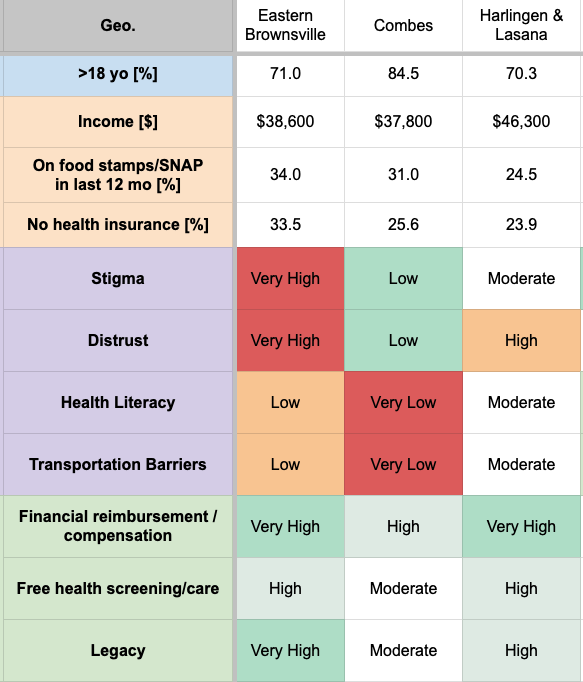How Tea Leaf Health helped McAllen Research analyze 1,000+ community groups in the Rio Grande Valley to identify the 10 best community partners, reaching 13,518 patients at risk for liver disease.
McAllen Research needed to connect Hispanic, overweight patients in the Rio Grande Valley to free MASH (fatty liver disease) screening. Their constraint? A part-time community engagement employee (Promatora) with just a few hours per week for outreach.
The challenge: Which organizations should she approach? Traditional approaches would mean months of manual research, cold calls, and low-probability partnerships. They needed a data-driven strategy to identify the highest-ROI partners quickly.
Step 1: Profile the Target Population & Map Barriers
We profiled 62 zip codes within 60 minutes' drive of McAllen Research, scoring each area on:
- Health literacy levels
- Stigma around fatty liver disease diagnosis
- Transportation barriers
- Financial expectations
- Trust in medical institutions

Key insight: In areas with high stigma and low health literacy, patients needed to hear about liver disease testing from trusted community voices, not clinical institutions.
Step 2: Screen 1,000+ Organizations & Score for Strategic Fit
Using PartnerIQ, we screened over 1,000 organizations and scored each based on three critical criteria:
1. Mission alignment: Does their core mission align with health equity and serving Hispanic populations?
2. Incentive alignment: Would referring patients align with their goals? (For example, a dentist office likely wouldn't make referrals—it would compete with their core business)
3. Patient access: Do they regularly engage with Hispanic, overweight individuals interested in health screening?
We focused specifically on non-clinical partners—community organizations, social service agencies, faith-based groups, and wellness centers with trust and access but no competing clinical interests.
Step 3: Deliver Actionable Partner Intelligence
From 1,000+ organizations, we identified the top 10 highest-ROI partners and provided:

- Organization details and "champion" contact info
- Strategic reasoning: Why this partner was selected
- Key motivators: What matters to them and how the partnership benefits them
- Custom talking points: Messaging tailored to each organization's mission
Every outreach conversation could be strategic and personalized, not generic.
✅ 1,000+ organizations screened and evaluated for recruitment partner potential
✅ 20 of the highest-ranked non-clinical partner opportunities shared with the Promotora
✅ 13,518 patients were estimated who fit the target profile of patients at risk for fatty liver disease
✅ 2,704 patients classified as highly activatable through trusted channels
Rather than spending months on research and low-probability cold calls, McAllen Research's community engagement employee could focus on 10 high-opportunity community partners through whom the Promotora could engage relevant patients. We'd done the strategic work of evaluating mission alignment, incentive alignment, and patient access, so every organization was pre-qualified, not just a name in a database.
For digital health companies entering new markets or patient recruitment teams with limited resources, this means every outreach hour has maximum ROI potential.
Ready to reach more patients through high-impact community partnerships? Book a Demo